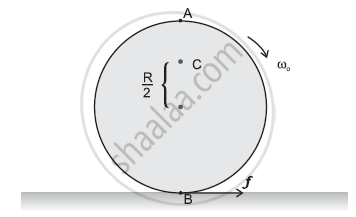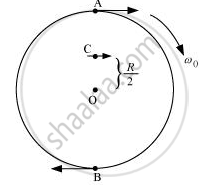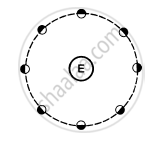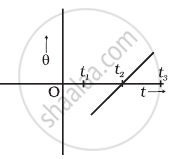Advertisements
Advertisements
Question
A disc rotating about its axis with angular speed ωois placed lightly (without any translational push) on a perfectly frictionless table. The radius of the disc is R. What are the linear velocities of the points A, B and C on the disc shown in Figure? Will the disc roll in the direction indicated?

Solution 1
vA = Rωo; vB = Rωo; `v_c = (R/2)omega_o`
The disc will not roll Angular speed of the disc = ωo
Radius of the disc = R
Using the relation for linear velocity, v = ωoR
For point A:
vA = Rωo; in the direction tangential to the right
For point B:
vB = Rωo; in the direction tangential to the left
For point C:
`v_c = (R/2)omega_o` in the direction same as that of vA
The directions of motion of points A, B, and C on the disc are shown in the following figure

Since the disc is placed on a frictionless table, it will not roll. This is because the presence of friction is essential for the rolling of a body.
Solution 2
Since `v = romega`
For Point A, `v_A = Romega_0` in the direction of arrow
For point B, `v_B = Romega_0` in the opposite direction of arrow
For point C, `v_C = R/2omega_0` in the direction of arrow
The disc will not roll in the given direction because friction is necessary for the same
APPEARS IN
RELATED QUESTIONS
The moon rotates about the earth in such a way that only one hemisphere of the moon faces the earth (see the following figure). Can we ever see the "other face" of the moon from the earth? Can a person on the moon ever see all the faces of the earth?

A sphere rolls on a horizontal surface. If there any point of the sphere which has a vertical velocity?
The angular velocity of the engine (and hence of the wheel) of a scooter is proportional to the petrol input per second. The scooter is moving on a frictionless road with uniform velocity. If the petrol input is increased by 10%, the linear velocity of the scooter is increased by ___________ .
A disc of radius 10 cm is rotating about its axis at an angular speed of 20 rad/s. Find the linear speed of a point on the rim.
A block hangs from a string wrapped on a disc of radius 20 cm free to rotate about its axis which is fixed in a horizontal position. If the angular speed of the disc is 10 rad/s at some instant, with what speed is the block going down at that instant?
A wheel rotating at a speed of 600 rpm (revolutions per minute) about its axis is brought to rest by applying a constant torque for 10 seconds. Find the angular deceleration and the angular velocity 5 seconds after the application of the torque.
A wheel of mass 10 kg and radius 20 cm is rotating at an angular speed of 100 rev/min when the motor is turned off. Neglecting the friction at the axle, calculate the force that must be applied tangentially to the wheel to bring it to rest in 10 revolutions.
A ball falls on the ground from a height of 2.0 m and rebounds up to a height of 1.5 m. Find the coefficient of restitution.
The variation of angular position θ, of a point on a rotating rigid body, with time t is shown in figure. Is the body rotating clock-wise or anti-clockwise?

Two cylindrical hollow drums of radii R and 2R, and of a common height h, are rotating with angular velocities ω(anti-clockwise) and ω(clockwise), respectively. Their axes, fixed are parallel and in a horizontal plane separated by (3R + δ). They are now brought in contact (δ → 0).
- Show the frictional forces just after contact.
- Identify forces and torques external to the system just after contact.
- What would be the ratio of final angular velocities when friction ceases?
